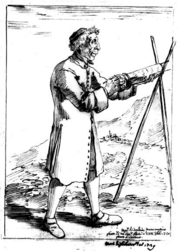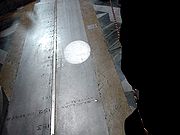
Francesco Bianchini
Encyclopedia

Italy
Italy , officially the Italian Republic languages]] under the European Charter for Regional or Minority Languages. In each of these, Italy's official name is as follows:;;;;;;;;), is a unitary parliamentary republic in South-Central Europe. To the north it borders France, Switzerland, Austria and...
philosopher and scientist
Scientist
A scientist in a broad sense is one engaging in a systematic activity to acquire knowledge. In a more restricted sense, a scientist is an individual who uses the scientific method. The person may be an expert in one or more areas of science. This article focuses on the more restricted use of the word...
. He worked for the curia
Curia
A curia in early Roman times was a subdivision of the people, i.e. more or less a tribe, and with a metonymy it came to mean also the meeting place where the tribe discussed its affairs...
of three popes, including being camiere d`honore of Clement XI, and secretary of the commission for the reform of the calendar
Calendar
A calendar is a system of organizing days for social, religious, commercial, or administrative purposes. This is done by giving names to periods of time, typically days, weeks, months, and years. The name given to each day is known as a date. Periods in a calendar are usually, though not...
, working on the method to calculate the astronomically correct date for Easter
Easter
Easter is the central feast in the Christian liturgical year. According to the Canonical gospels, Jesus rose from the dead on the third day after his crucifixion. His resurrection is celebrated on Easter Day or Easter Sunday...
in a given year.
Life and work
Bianchini was born of a noble family at VeronaVerona
Verona ; German Bern, Dietrichsbern or Welschbern) is a city in the Veneto, northern Italy, with approx. 265,000 inhabitants and one of the seven chef-lieus of the region. It is the second largest city municipality in the region and the third of North-Eastern Italy. The metropolitan area of Verona...
, the Son of Giuseppe Bianchini and his wife, Cornelia Vailetti. In 1684 he went to Rome
Rome
Rome is the capital of Italy and the country's largest and most populated city and comune, with over 2.7 million residents in . The city is located in the central-western portion of the Italian Peninsula, on the Tiber River within the Lazio region of Italy.Rome's history spans two and a half...
, and became librarian to Cardinal Ottoboni, who, as Pope Alexander VIII
Pope Alexander VIII
Pope Alexander VIII , born Pietro Vito Ottoboni, was Pope from 1689 to 1691.-Early life:Pietro Ottoboni was born of a noble Venetian family, and was the son of Marco Ottoboni, chancellor of the Republic of Venice...
(1689), raised him to the offices of papal chamberlain and canon of Santa Maria Maggiore
Basilica di Santa Maria Maggiore
The Papal Basilica of Saint Mary Major , known also by other names, is the largest Roman Catholic Marian church in Rome, Italy.There are other churches in Rome dedicated to Mary, such as Santa Maria in Trastevere, Santa Maria in Aracoeli, Santa Maria sopra Minerva, but the greater size of the...
. Clement XI sent him on a mission to Paris
Paris
Paris is the capital and largest city in France, situated on the river Seine, in northern France, at the heart of the Île-de-France region...
in 1712, and employed him to form a museum of Christian antiquities. A paper by him on Giovanni Domenico Cassini
Giovanni Domenico Cassini
This article is about the Italian-born astronomer. For his French-born great-grandson, see Jean-Dominique Cassini.Giovanni Domenico Cassini was an Italian/French mathematician, astronomer, engineer, and astrologer...
's new method of parallax
Parallax
Parallax is a displacement or difference in the apparent position of an object viewed along two different lines of sight, and is measured by the angle or semi-angle of inclination between those two lines. The term is derived from the Greek παράλλαξις , meaning "alteration"...
es was inserted in the Ada Eruditorum of Leipzig
Leipzig
Leipzig Leipzig has always been a trade city, situated during the time of the Holy Roman Empire at the intersection of the Via Regia and Via Imperii, two important trade routes. At one time, Leipzig was one of the major European centres of learning and culture in fields such as music and publishing...
in 1685.
He was elected a Fellow of the Royal Society of London in January, 1713 after being proposed by Sir Isaac Newton.

Aerial telescope
An aerial telescope is a type of very-long-focal-length refracting telescope built in the second half of the 17th century that did not use a tube. Instead, the objective was mounted on a pole, tree, tower, building or other structure on a swivel ball-joint. The observer stood on the ground and held...
. Today, we know that this is impossible, because of the thick cloud cover on this planet
Planet
A planet is a celestial body orbiting a star or stellar remnant that is massive enough to be rounded by its own gravity, is not massive enough to cause thermonuclear fusion, and has cleared its neighbouring region of planetesimals.The term planet is ancient, with ties to history, science,...
. He also worked on the parallax of Venus, and he measured the precession of the Earth
Earth
Earth is the third planet from the Sun, and the densest and fifth-largest of the eight planets in the Solar System. It is also the largest of the Solar System's four terrestrial planets...
's rotational axis.
As part of his efforts to improve the accuracy of the calendar, Bianchini was commissioned by Pope Clement XI
Pope Clement XI
Pope Clement XI , born Giovanni Francesco Albani, was Pope from 1700 until his death in 1721.-Early life:...
to construct an important meridian line in the Basilica of Santa Maria degli Angeli e dei Martiri
Santa Maria degli Angeli e dei Martiri
The Basilica of St. Mary of the Angels and the Martyrs is a titular basilica church in Rome, built inside the frigidarium of the Baths of Diocletian. The Cardinal priest of the is William Henry Keeler.- The basilica :...
(the Basilica of Saint Mary of the Angels and the Martyrs) in Rome
Rome
Rome is the capital of Italy and the country's largest and most populated city and comune, with over 2.7 million residents in . The city is located in the central-western portion of the Italian Peninsula, on the Tiber River within the Lazio region of Italy.Rome's history spans two and a half...
, a device for calculating the position of the sun and stars. According to a Catholic News Service online news story by Carol Glatz from August 5, 2011, Pope Benedict XVI
Pope Benedict XVI
Benedict XVI is the 265th and current Pope, by virtue of his office of Bishop of Rome, the Sovereign of the Vatican City State and the leader of the Catholic Church as well as the other 22 sui iuris Eastern Catholic Churches in full communion with the Holy See...
noted this when he explained the importance of astronomy- especially when clocks were primitive and prone to error- in the determination of certain liturgical celebration days and the times for certain daily prayers, such as the Angelus
Angelus
The Angelus is a Christian devotion in memory of the Incarnation. The name Angelus is derived from the opening words: Angelus Domini nuntiavit Mariæ The Angelus (Latin for "angel") is a Christian devotion in memory of the Incarnation. The name Angelus is derived from the opening words: Angelus...
.
<
His point of view on the Copernican system is not evident, but it was noted that the picture of the planetary system in his book about Venus has an empty center.
Craters
Impact crater
In the broadest sense, the term impact crater can be applied to any depression, natural or manmade, resulting from the high velocity impact of a projectile with a larger body...
on Mars
Mars
Mars is the fourth planet from the Sun in the Solar System. The planet is named after the Roman god of war, Mars. It is often described as the "Red Planet", as the iron oxide prevalent on its surface gives it a reddish appearance...
and the Moon
Bianchini (lunar crater)
Bianchini is a lunar crater that lies besides the northern Jura Mountains that ring the Sinus Iridum, in the northwestern part of the Moon. The impact of this crater near the edge of the Jura Mountains pushed some material into the Sinus Iridum floor....
are named in his honor.
He also worked as a topographer and archaeologist of ancient Rome, and as a collector.
Books by Bianchini
He published many books, including:- Storia universale, provata co' monumenti, e figurata co' simboli degli antichi (Rome, 1697 and 1747)
- De Calendario et Cyclo Caesaris (1703)
- De vitis romanorum pontificum a Petro Apost. ad Nicolaum I. 4 vol. (Rome, 1718–35)
- Hesperi et Phosphori nova phaenomena sive observationes circa planetam Veneris (Rome, 1728), in which he asserted VenusVenusVenus is the second planet from the Sun, orbiting it every 224.7 Earth days. The planet is named after Venus, the Roman goddess of love and beauty. After the Moon, it is the brightest natural object in the night sky, reaching an apparent magnitude of −4.6, bright enough to cast shadows...
to rotate in 24 days and 8 hours. - (posthumously) Astronomicae et Geographicae Observationes Selectae (1737) and
- Opuscula Varia (1754).
External links
- Catholic Encyclopedia engl.
- Kurzbeschreibung Hesperi et Phosphori nova phaenomena…
- Bianchini's Globe of Venus, 1727. Astronomical Museum Museo della Specola, Bologna

